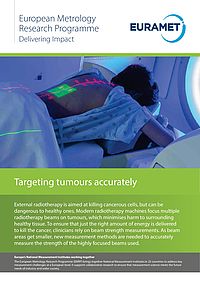A wide range of physical, chemical and biological approaches are used to treat diseases and otherhealth conditions, including drugs or physical therapies such as radiotherapy and ultrasound. All ofthese have risks as well as benefits, and accurate measurement is essential to ensure that thetreatment delivered will cure or manage the condition while minimising any harmful side-effects. All therapies require practical, accurate measurement methods and tools for use in healthcare environments.

BETTER FLOW MEASUREMENT, SAFER PATIENTS
Vulnerable patients receiving drug infusions in intensive care or for palliative relief require low volume drug delivery over extended time periods. Infusion systems operating at very slow rates are used to deliver these drugs. Accurate calibrations of the entire infusion system, from the drug reservoir to the patient are required, but current European calibration facilities cannot match hospital needs. Improved EU calibration facilities are required to support delivery of these crucial drugs.
Download the full case study

FAST TRACK TO DRUG DISCOVERY
Identifying new drugs is an expensive business. Drug discovery takes time and may offer developers a relatively low payback, especially for new antibiotic compounds. New, rapid methods to identify potential drugs could reduce cost and accelerate the introduction of new treatments. This is particularly important for antibiotics where many of our current drugs are becoming ineffective as resistance to them develops in the microorganisms they are designed to attack.
Download the full case study

ACCURATE DOSE MEANS EFFECTIVE THERAPY
Accurate dose means effective therapy
Molecular radiotherapy can target cancers by going directly to the cancer site. Getting the right amount of a radioactive drug to the cancer is critical, but we are all different and individual responses vary to the same treatment. Accurate radioactivity measurements and sophisticated imaging techniques with the potential to measure the drug’s delivery inside the body are needed to ensure effective personalised cancer care.
Download the full case study

Traceability Boosts Cancer Therapy
Molecular radiotherapy (MRT) effectively targets cancer while minimising damage to healthy tissue. It relies on safely getting short-lived radioactive products directly to the tumour and monitoring up-take using complex patient imaging. The accuracy of these measurements depends on the calibration of instruments for measuring radioactivity, using a method that gives traceability to the SI. Reducing the existing calibration chain will increase administered drug accuracy and lead to optimised individual MRT patient therapies.
Download the full case study

Hitting the target for cancer
Molecular radiotherapy (MRT) is an innovative treatment that effectively targets cancer cells and has great potential to offer personalised treatment tailored to an individual patient’s needs. The key to wider use of MRT is accurate measurement. Improved measurement methods and use of sophisticated medical imaging techniques are needed to ensure that the dose delivered to the tumour can be confidently predicted from the measured radioactivity of the pharmaceutical or device before use.
Download the full case study

HIGH INTENSITY ULTRASOUND TREATMENTS
High Intensity Focused Ultrasound (HIFU) is a promising new cancer treatment technique. It uses multiple soundwave beams which travel to tumours without harming healthy cells on the way – enabling safer treatment and opening possibilities for treating cancers deep within the body and brain. But as a new technology, it so far lacks standards and measurement methods to ensure accurate delivery of the sound energy that destroys the cancer.
Download full case study

TARGETING TUMOURS ACCURATELY
External radiotherapy is aimed at killing cancerous cells, but can be dangerous to healthy ones. Modern radiotherapy machines focus multiple radiotherapy beams on tumours, which minimises harm to surrounding healthy tissue. To ensure that just the right amount of energy is delivered to kill the cancer, clinicians rely on beam strength measurements. As beam areas get smaller, new measurement methods are needed to accurately measure the strength of the highly focused beams used.
Download full case study